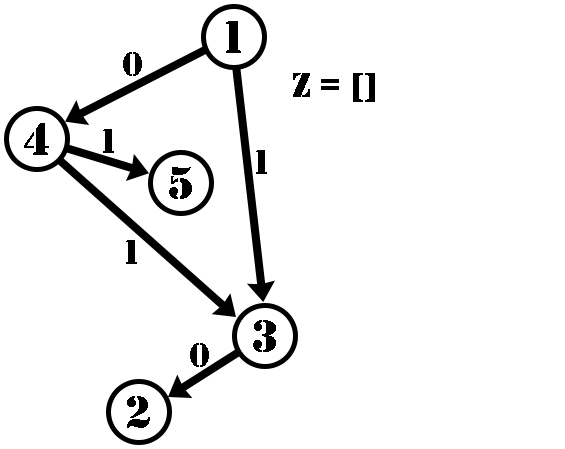CF1866C.Completely Searching for Inversions
普及/提高-
通过率:0%
AC君温馨提醒
该题目为【codeforces】题库的题目,您提交的代码将被提交至codeforces进行远程评测,并由ACGO抓取测评结果后进行展示。由于远程测评的测评机由其他平台提供,我们无法保证该服务的稳定性,若提交后无反应,请等待一段时间后再进行重试。
题目描述
Pak Chanek has a directed acyclic graph (a directed graph that does not have any cycles) containing N vertices. Vertex i has Si edges directed away from that vertex. The j -th edge of vertex i that is directed away from it, is directed towards vertex Li,j and has an integer Wi,j ( 0≤Wi,j≤1 ). Another information about the graph is that the graph is shaped in such a way such that each vertex can be reached from vertex 1 via zero or more directed edges.
Pak Chanek has an array Z that is initially empty.
Pak Chanek defines the function dfs as follows:
<pre class="lstlisting">```
// dfs from vertex i<br></br>void dfs(int i) {<br></br> // iterate each edge of vertex i that is directed away from it<br></br> for(int j = 1; j <= S[i]; j++) {<br></br> Z.push_back(W[i][j]); // add the integer in the edge to the end of Z<br></br> dfs(L[i][j]); // recurse to the next vertex<br></br> }<br></br>}<br></br>
Note that the function does not keep track of which vertices have been visited, so each vertex can be processed more than once.
Let's say Pak Chanek does dfs(1) once. After that, Pak Chanek will get an array $Z$ containing some elements $0$ or $1$ . Define an inversion in array $Z$ as a pair of indices $(x, y)$ ( $x < y$ ) such that $Z_x > Z_y$ . How many different inversions in $Z$ are there if Pak Chanek does dfs(1) once? Since the answer can be very big, output the answer modulo $998\,244\,353$ .输入格式
The first line contains a single integer N ( 2≤N≤105 ) — the number of vertices in the graph. The following lines contain the description of each vertex from vertex 1 to vertex N .
The first line of each vertex i contains a single integer Si ( 0≤Si≤N−1 ) — the number of edges directed away from vertex i .
The j -th of the next Si lines of each vertex i contains two integers Li,j and Wi,j ( 1≤Li,j≤N ; 0≤Wi,j≤1 ) — an edge directed away from vertex i that is directed towards vertex Li,j and has an integer Wi,j . For each i , the values of Li,1 , Li,2 , ..., Li,Si are pairwise distinct.
It is guaranteed that the sum of Si over all vertices does not exceed 2⋅105 . There are no cycles in the graph. Each vertex can be reached from vertex 1 via zero or more directed edges.
输出格式
An integer representing the number of inversions in Z if Pak Chanek does dfs(1) once. Since the answer can be very big, output the answer modulo 998244353 .
输入输出样例
输入#1
5 2 4 0 3 1 0 1 2 0 2 3 1 5 1 0
输出#1
4
说明/提示
The following is the dfs(1) process on the graph.

In the end, Z=[0,1,0,1,1,0] . All of its inversions are (2,3) , (2,6) , (4,6) , and (5,6) .